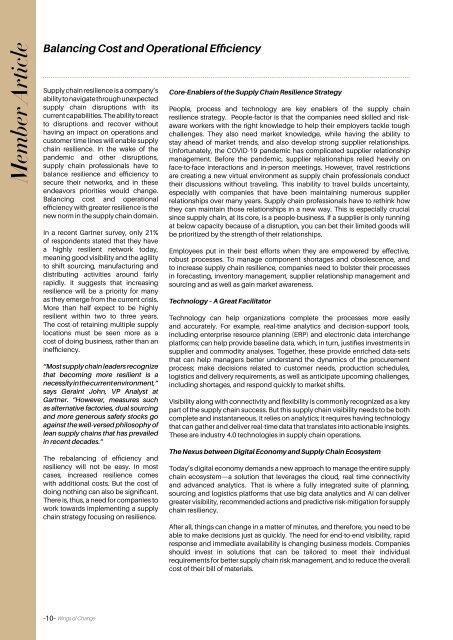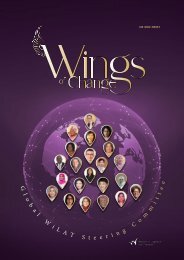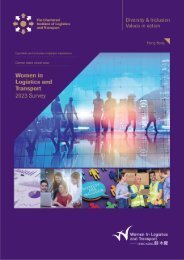Wings of Change Newsletter October 2023
The 9th edition of the newsletter from WiLAT
The 9th edition of the newsletter from WiLAT
You also want an ePaper? Increase the reach of your titles
YUMPU automatically turns print PDFs into web optimized ePapers that Google loves.
Member Article<br />
Balancing Cost and Operational Efficiency<br />
Supply chain resilience is a company’s<br />
ability to navigate through unexpected<br />
supply chain disruptions with its<br />
current capabilities. The ability to react<br />
to disruptions and recover without<br />
having an impact on operations and<br />
customer time lines will enable supply<br />
chain resilience. In the wake <strong>of</strong> the<br />
pandemic and other disruptions,<br />
supply chain pr<strong>of</strong>essionals have to<br />
balance resilience and efficiency to<br />
secure their networks, and in these<br />
endeavors priorities would change.<br />
Balancing cost and operational<br />
efficiency with greater resilience is the<br />
new norm in the supply chain domain.<br />
In a recent Gartner survey, only 21%<br />
<strong>of</strong> respondents stated that they have<br />
a highly resilient network today,<br />
meaning good visibility and the agility<br />
to shift sourcing, manufacturing and<br />
distributing activities around fairly<br />
rapidly. It suggests that increasing<br />
resilience will be a priority for many<br />
as they emerge from the current crisis.<br />
More than half expect to be highly<br />
resilient within two to three years.<br />
The cost <strong>of</strong> retaining multiple supply<br />
locations must be seen more as a<br />
cost <strong>of</strong> doing business, rather than an<br />
inefficiency.<br />
“Most supply chain leaders recognize<br />
that becoming more resilient is a<br />
necessity in the current environment,”<br />
says Geraint John, VP Analyst at<br />
Gartner. “However, measures such<br />
as alternative factories, dual sourcing<br />
and more generous safety stocks go<br />
against the well-versed philosophy <strong>of</strong><br />
lean supply chains that has prevailed<br />
in recent decades.”<br />
The rebalancing <strong>of</strong> efficiency and<br />
resiliency will not be easy. In most<br />
cases, increased resilience comes<br />
with additional costs. But the cost <strong>of</strong><br />
doing nothing can also be significant.<br />
There is, thus, a need for companies to<br />
work towards implementing a supply<br />
chain strategy focusing on resilience.<br />
Core-Enablers <strong>of</strong> the Supply Chain Resilience Strategy<br />
People, process and technology are key enablers <strong>of</strong> the supply chain<br />
resilience strategy. People-factor is that the companies need skilled and riskaware<br />
workers with the right knowledge to help their employers tackle tough<br />
challenges. They also need market knowledge, while having the ability to<br />
stay ahead <strong>of</strong> market trends, and also develop strong supplier relationships.<br />
Unfortunately, the COVID-19 pandemic has complicated supplier relationship<br />
management. Before the pandemic, supplier relationships relied heavily on<br />
face-to-face interactions and in-person meetings. However, travel restrictions<br />
are creating a new virtual environment as supply chain pr<strong>of</strong>essionals conduct<br />
their discussions without traveling. This inability to travel builds uncertainty,<br />
especially with companies that have been maintaining numerous supplier<br />
relationships over many years. Supply chain pr<strong>of</strong>essionals have to rethink how<br />
they can maintain those relationships in a new way. This is especially crucial<br />
since supply chain, at its core, is a people-business. If a supplier is only running<br />
at below capacity because <strong>of</strong> a disruption, you can bet their limited goods will<br />
be prioritized by the strength <strong>of</strong> their relationships.<br />
Employees put in their best efforts when they are empowered by effective,<br />
robust processes. To manage component shortages and obsolescence, and<br />
to increase supply chain resilience, companies need to bolster their processes<br />
in forecasting, inventory management, supplier relationship management and<br />
sourcing and as well as gain market awareness.<br />
Technology – A Great Facilitator<br />
Technology can help organizations complete the processes more easily<br />
and accurately. For example, real-time analytics and decision-support tools,<br />
including enterprise resource planning (ERP) and electronic data interchange<br />
platforms; can help provide baseline data, which, in turn, justifies investments in<br />
supplier and commodity analyses. Together, these provide enriched data-sets<br />
that can help managers better understand the dynamics <strong>of</strong> the procurement<br />
process; make decisions related to customer needs, production schedules,<br />
logistics and delivery requirements, as well as anticipate upcoming challenges,<br />
including shortages, and respond quickly to market shifts.<br />
Visibility along with connectivity and flexibility is commonly recognized as a key<br />
part <strong>of</strong> the supply chain success. But this supply chain visibility needs to be both<br />
complete and instantaneous. It relies on analytics; it requires having technology<br />
that can gather and deliver real-time data that translates into actionable insights.<br />
These are industry 4.0 technologies in supply chain operations.<br />
The Nexus between Digital Economy and Supply Chain Ecosystem<br />
Today’s digital economy demands a new approach to manage the entire supply<br />
chain ecosystem—a solution that leverages the cloud, real time connectivity<br />
and advanced analytics. That is where a fully integrated suite <strong>of</strong> planning,<br />
sourcing and logistics platforms that use big data analytics and AI can deliver<br />
greater visibility, recommended actions and predictive risk-mitigation for supply<br />
chain resiliency.<br />
After all, things can change in a matter <strong>of</strong> minutes, and therefore, you need to be<br />
able to make decisions just as quickly. The need for end-to-end visibility, rapid<br />
response and immediate availability is changing business models. Companies<br />
should invest in solutions that can be tailored to meet their individual<br />
requirements for better supply chain risk management, and to reduce the overall<br />
cost <strong>of</strong> their bill <strong>of</strong> materials.<br />
-10- <strong>Wings</strong> <strong>of</strong> <strong>Change</strong>
















